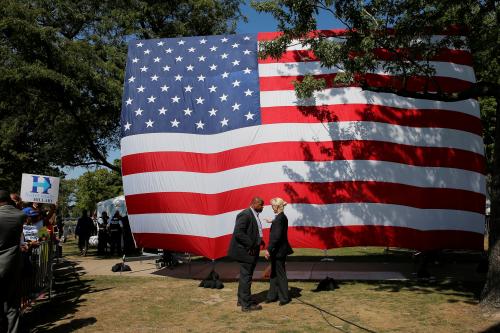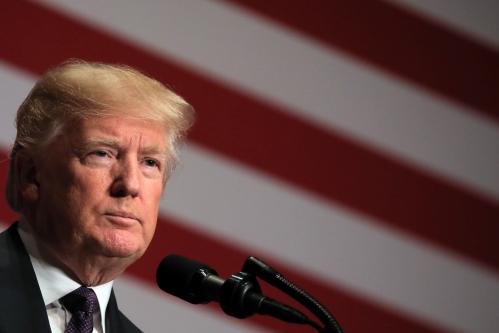While Donald Trump campaigned for president as a tough protectionist promising to upend American trade policy, his first year in office featured more inflammatory rhetoric than revolutionary policy change. A flurry of recent trade enforcement actions, however, have suggested that 2018 might be different.
In late January, the Trump administration announced it was imposing new tariffs on solar panels and washing machines. These tariffs originated from a “Section 201” investigation, a rarely used instrument of U.S. trade law that allows the president to temporarily limit imports if domestic industries are threatened with injury. While the use of such safeguard measures are rare, this decision was by no means unprecedented—George W. Bush used the same Section 201 process to impose limits on foreign steel imports in 2002.
Meanwhile, the administration continues to debate imposing new restrictions on steel and aluminum. Last year, the White House ordered a so-called “Section 232” investigation into whether these imports threaten national security. Like the use of Section 201 of U.S. trade law, these Section 232 investigations are rare but still within the bounds of recent American trade practice; similar investigations were launched in 1999 on crude oil and in 2001 on iron ore and steel. Earlier today, Commerce Secretary Wilbur Ross confirmed that his department has recommended significant new tariffs and quotas on both steel and aluminum; Trump will now have until mid-April to make a final decision on how to proceed. At a recent meeting with congressional leaders, Trump seemed to suggest he was leaning toward imposing tariffs, opining, “If we ever have a conflict, we don’t want to be buying the steel from a country that we’re fighting because somehow that doesn’t work very well.” Yet at that same meeting many Republican lawmakers cautioned against limiting steel or aluminum imports, as many jobs in the country depend on these products as inputs for higher value added manufacturing. And many members of Trump’s foreign policy and national security team, including Secretary of State Rex Tillerson and Secretary of Defense James Mathis, also reportedly oppose the new tariffs, arguing that they will hurt American allies and complicate diplomatic relationships.
Finally, the administration is also preparing a decision on its “Section 301” investigation into Chinese intellectual property and technology transfer rules. Section 301 gives broad discretion to the president to retaliate against unfair foreign trade practices; decades ago it was a mainstay of U.S. trade enforcement policy, but since the advent of the World Trade Organization the rule has been used infrequently. Recent reporting suggests that while Trump is again keen to push forward with aggressive action, other officials within the administration are cautious of legal liability arising from acting beyond normal processes. There are also some reports that the U.S. might partner with the European Union and Japan to take this issue up multilaterally through the WTO, rather than unilaterally.
Do these actions imply Trump is upending American trade enforcement? Not necessarily. Indeed, what is notable about Trump’s trade enforcement record is that, while he continually reveals his personal instincts for dramatic, aggressive action—such as calling last week for a “reciprocal tax” on trading partners—to date these instincts have been tempered by the political and legal constraints of America’s trade bureaucracy. Last month brought further evidence of how America’s trade enforcement procedures remain, for the most part, insulated from political pressures. The U.S. International Trade Commission ruled against Boeing’s petition to impose duties on the Canadian plane maker Bombardier, clearing the way for Bombardier’s sale of jets to Delta. This decision was a welcome surprise for many advocates of free trade, in one of the most high profile anti-dumping cases of the Trump era. (Bombardier’s stock jumped 15 percent on the news.) The ITC demonstrated that, whatever Trump’s instincts on protectionism may be, the professionals responsible for actually carrying out trade enforcement have not changed their ways.
It remains to be seen how both the Section 232 and Section 301 cases will play out. For now, however, Trump’s trade enforcement record is more traditionalist than revolutionary. His administration is digging deep into the existing U.S. trade enforcement playbook, dusting off enforcement tools that have not been used in years, but they are not ripping up this playbook altogether. They are willing to push the limits of the existing system, but are not fundamentally overturning it; perhaps not a surprise given that Robert Lighthizer, Trump’s top trade official, has spent most of his career within this system.
The longer term impact of this enforcement streak will depend on how targeted countries respond. Here, so far, signs are mostly encouraging—countries that have been targeted by U.S. trade actions have for the most part been filing complaints at the WTO, rather than unilaterally hitting back at the U.S. Earlier this month, however, China announced it was investigating the dumping of U.S. sorghum exports, signaling that it is willing and able to retaliate against American trade policy if necessary. Even here, however, it appears that China is seeking to avoid further escalation by looking for a discriminate, proportionate response to U.S. pressure.
Ultimately, even if the actual enforcement record of the Trump administration falls short of its rhetoric, this doesn’t mean the rhetoric is costless. When the American president constantly complains about how all other countries are cheating and every free trade agreement is a terrible deal, the U.S. becomes a less appealing, more erratic trade partner in the eyes of our allies. Indeed, when Trump floated the idea last month that the U.S. might be interested in re-joining the Trans Pacific Partnership trade deal, the 11 countries that have agreed to the deal showed little interest in making any real effort to bring the U.S. back in. While the Trump administration is busy digging up decades-old trade enforcement measures, the rest of the world is moving forward.







Commentary
Is Trump remaking American trade enforcement policy?
February 16, 2018